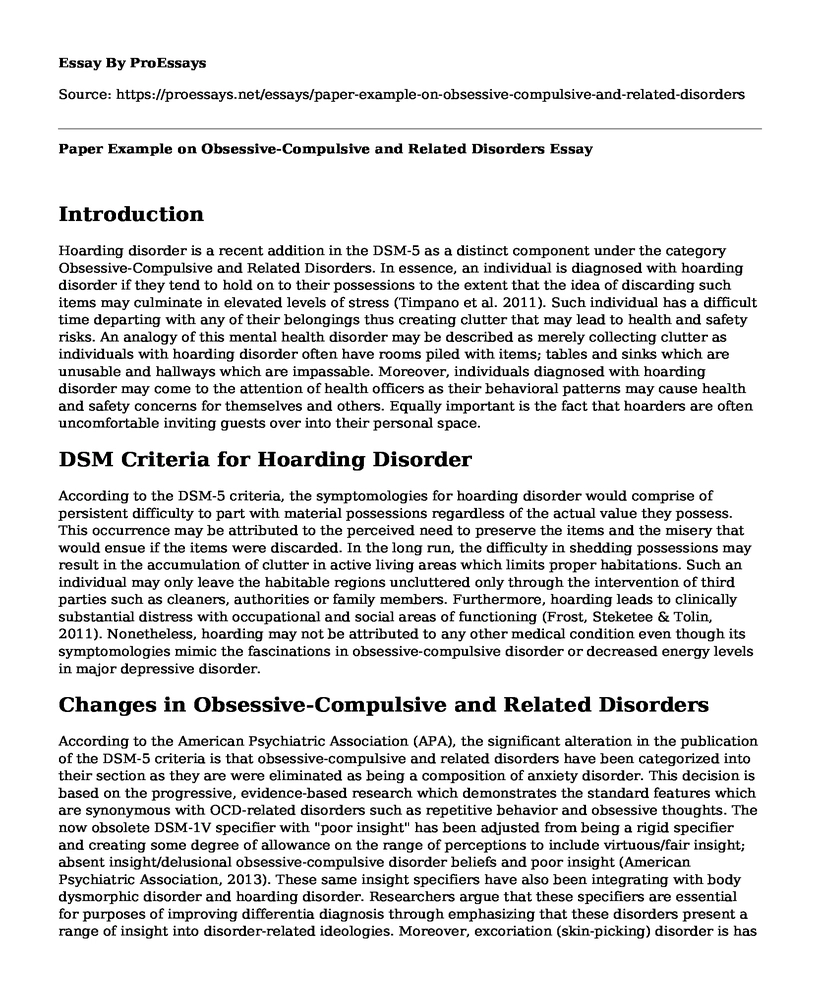Introduction
Hoarding disorder is a recent addition in the DSM-5 as a distinct component under the category Obsessive-Compulsive and Related Disorders. In essence, an individual is diagnosed with hoarding disorder if they tend to hold on to their possessions to the extent that the idea of discarding such items may culminate in elevated levels of stress (Timpano et al. 2011). Such individual has a difficult time departing with any of their belongings thus creating clutter that may lead to health and safety risks. An analogy of this mental health disorder may be described as merely collecting clutter as individuals with hoarding disorder often have rooms piled with items; tables and sinks which are unusable and hallways which are impassable. Moreover, individuals diagnosed with hoarding disorder may come to the attention of health officers as their behavioral patterns may cause health and safety concerns for themselves and others. Equally important is the fact that hoarders are often uncomfortable inviting guests over into their personal space.
DSM Criteria for Hoarding Disorder
According to the DSM-5 criteria, the symptomologies for hoarding disorder would comprise of persistent difficulty to part with material possessions regardless of the actual value they possess. This occurrence may be attributed to the perceived need to preserve the items and the misery that would ensue if the items were discarded. In the long run, the difficulty in shedding possessions may result in the accumulation of clutter in active living areas which limits proper habitations. Such an individual may only leave the habitable regions uncluttered only through the intervention of third parties such as cleaners, authorities or family members. Furthermore, hoarding leads to clinically substantial distress with occupational and social areas of functioning (Frost, Steketee & Tolin, 2011). Nonetheless, hoarding may not be attributed to any other medical condition even though its symptomologies mimic the fascinations in obsessive-compulsive disorder or decreased energy levels in major depressive disorder.
Changes in Obsessive-Compulsive and Related Disorders
According to the American Psychiatric Association (APA), the significant alteration in the publication of the DSM-5 criteria is that obsessive-compulsive and related disorders have been categorized into their section as they are were eliminated as being a composition of anxiety disorder. This decision is based on the progressive, evidence-based research which demonstrates the standard features which are synonymous with OCD-related disorders such as repetitive behavior and obsessive thoughts. The now obsolete DSM-1V specifier with "poor insight" has been adjusted from being a rigid specifier and creating some degree of allowance on the range of perceptions to include virtuous/fair insight; absent insight/delusional obsessive-compulsive disorder beliefs and poor insight (American Psychiatric Association, 2013). These same insight specifiers have also been integrating with body dysmorphic disorder and hoarding disorder. Researchers argue that these specifiers are essential for purposes of improving differentia diagnosis through emphasizing that these disorders present a range of insight into disorder-related ideologies. Moreover, excoriation (skin-picking) disorder is has been incorporated in DSM-5 as evidence-based research indicates that approximately 2-4 percent of the population are likely to be identified with this mental disorders as evidenced by a large research base. The resultant effects of the excoriation disorder include skin lesions, physical disfigurement, infections and scarring.
Conclusion
In summary, the unique change in DSM-5 accentuates that the presence of absent discernment/delusional beliefs leads to the conclusion of the appropriate obsessive-compulsive or a related disorder instead of diagnosing for schizophrenic symptomologies and any other psychotic disorder. Equally important is the fact that the incorporation of this specifiers in diagnostic criteria for obsessive-compulsive disorder demonstrates the clinical and empirical legitimacy through the identification of present and past comorbid tic disorder.
References
American Psychiatric Association. (2013). Diagnostic and statistical manual of mental disorders (DSM-5). American Psychiatric Pub.
Frost, R. O., Steketee, G., & Tolin, D. F. (2011). Comorbidity in hoarding disorder. Depression and anxiety, 28(10), 876-884.
Timpano, K. R., Exner, C., Glaesmer, H., Rief, W., Keshaviah, A., Brahler, E., & Wilhelm, S. (2011). The epidemiology of the proposed DSM-5 hoarding disorder: exploration of the acquisition specifier, associated features, and distress. The Journal of clinical psychiatry.
Cite this page
Paper Example on Obsessive-Compulsive and Related Disorders. (2022, May 04). Retrieved from https://proessays.net/essays/paper-example-on-obsessive-compulsive-and-related-disorders
If you are the original author of this essay and no longer wish to have it published on the ProEssays website, please click below to request its removal:
- Mental Illness: Case Study
- Disaster and Post-Traumatic Experiences Essay
- Essay Sample on Adolescent Health
- Organization as the Solution to Fatigue - Essay Sample
- Essay Example on Lesbian Rights and BDSM: Establishing Mental Condition for Justice
- Essay Example on Sharpen the Saw: Self-Renewal to Enhance Your Life
- Social Experiments and Authority Dynamics: Unveiling Human Behavior and Challenges in Leadership - Report Example







